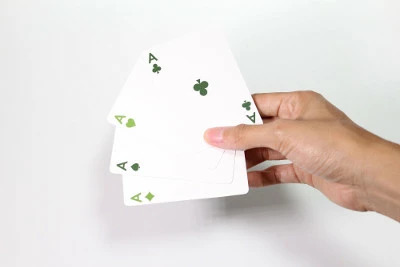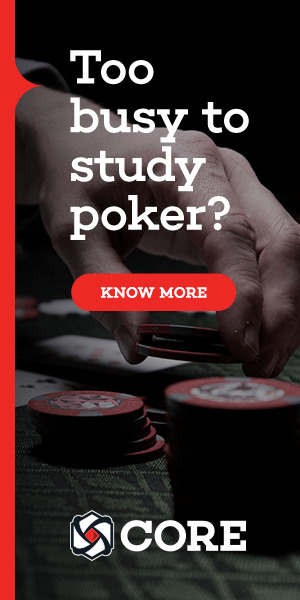
3
Apr, 2020
by sixmaxer
|
Apr 3, 2020
|
terminology
slang
jargon
definitions
lingo
|
0 comments
Position related terminology
These are the names of the positions clockwise round the table.
UTG: Under The Gun. The first seat after the Big Blind. This is the first person to act, so the player UTG will often be the first to act postflop. UTG is the first to act preflop.
MP or HJ: Middle Position or High Jack. The first seat(s) after UTG. In six-max, there is only one MP seat, but in full ring, there can be 2 - 3 MP seats (named MP2, MP3 etc.)
CO: Cut Off. The seat just before the BTN. Will often benefit from being in position postflop.
BTN: Button. The BTN is where the dealer button is placed. This seat has the benefit of being in position postflop.
SB: Small Blind. The SB has a forced bet of ½ BB preflop. This seat will always be out of position.
BB: Big Blind. The BB has a forced bet 1 BB preflop. This seat only has position on SB.
IP: In Position. Being IP or having position on someone is a huge advantage. It means that you always get to see the action of the opponent, before you act.
OOP: Out of Position. Being OOP means that you have to act first. This means that it is a lot harder to play perfect from OOP.
MP or HJ: Middle Position or High Jack. The first seat(s) after UTG. In six-max, there is only one MP seat, but in full ring, there can be 2 - 3 MP seats (named MP2, MP3 etc.)
CO: Cut Off. The seat just before the BTN. Will often benefit from being in position postflop.
BTN: Button. The BTN is where the dealer button is placed. This seat has the benefit of being in position postflop.
SB: Small Blind. The SB has a forced bet of ½ BB preflop. This seat will always be out of position.
BB: Big Blind. The BB has a forced bet 1 BB preflop. This seat only has position on SB.
IP: In Position. Being IP or having position on someone is a huge advantage. It means that you always get to see the action of the opponent, before you act.
OOP: Out of Position. Being OOP means that you have to act first. This means that it is a lot harder to play perfect from OOP.
Moves and actions
Limp: when someone enters the pot freflop by only calling the BB instead of raising.
Squeeze: when player one raises, and player two calls, it is called a squeeze if player three then re-raises (3-bets) the original bet. The idea behind this move is that it puts player one in an ackward position, since he now has to play against two opponents, and will often be OOP to at least one of them. Furthermore player two has shown some degree of weakness, since he only called instead of raising.
3-Bet: This term is tricky to get right, as it seems to have a different meaning preflop and postflop.
Preflop: Player one raises, and then player two re-raises (this re-raise is the preflop 3-bet).
Postflop: Player One raises, player two re-raises, and then either player three or player one re-re-raises (this re-re-raise is the postflop 3-bet).
The reason for this seemingly different meaning, is that the preflop posting of the blinds is the one-bet. Player ones preflop raise is the two-bet and the re-raise of player ones raise is the 3-bet.
Postflop we do not have the automatic one-bet from the blinds, so it seems that there is an extra raise, before we get to the 3-bet. Many people do not get this right, so they call the postflop re-raise a 3-bet. This is wrong - do not be one of them.
4-Bet: is raising a 3-bet.
3-Bet: This term is tricky to get right, as it seems to have a different meaning preflop and postflop.
Preflop: Player one raises, and then player two re-raises (this re-raise is the preflop 3-bet).
Postflop: Player One raises, player two re-raises, and then either player three or player one re-re-raises (this re-re-raise is the postflop 3-bet).
The reason for this seemingly different meaning, is that the preflop posting of the blinds is the one-bet. Player ones preflop raise is the two-bet and the re-raise of player ones raise is the 3-bet.
Postflop we do not have the automatic one-bet from the blinds, so it seems that there is an extra raise, before we get to the 3-bet. Many people do not get this right, so they call the postflop re-raise a 3-bet. This is wrong - do not be one of them.
4-Bet: is raising a 3-bet.
Math & Statistics
EV: Expected Value. Imagine you have a situation, where you sometimes win an amount of money, and sometimes you lose an amount of money. The amount you win is not necessarily the same amount that you win. How do you know if this is a good deal or a bad deal? You multiply the number of times you win by the amount of money you win, when you win (we can call the result totalwon). Similarly you multiply the number of times you lose by the amount you lose, when you lose (we call this result totallost). Your EV of the situation is then totalwon - totallost. If this number is positive, it is a good deal. In poker we think wider than just one hand. We think about the expected total, if we make the same action hundreds or thousands of times. You may lose the individual hand, but the move can still be +EV. Think in terms of losing the battle, but winning the war. Try the EV calculator here: https://pokernewb.com/expected_value, to get a better understanding of the term.
Pot Odds: When someone c-bets into you, you can call or fold. The pot odds are (or should be) one of the first things you consider, before you make the decision. The pot odds is a risk/reward calculation. If you have a low risk and a high reward, you should be more likely to call. Try the pot odds calculator here: https://pokernewb.com/pot_odds
Outs: Outs are the cards that will help your hand improve. Assume you are behind on the flop, but there are 10 cards, that could improve your hand on the turn or the river, we say that you have ten outs. Be aware that not all outs are clean outs. Clean outs will always give you the nuts, some outs will give you the nuts sometimes, but not othertimes - e.g. if you are drawing to a K-high flush draw, you can not be sure, that your opponent will not show up with A-high flush draw from time to time. Read more about outs and how to estimate your equity from them here: https://pokernewb.com/posts/the-rule-of-4-and-2
Equity: The amount of the pot, that 'belongs' to you based on the strength of your hand. If you fold, your equity drops to zero, so you can not realize your equity, unless you get to the river - or fold the opponent(s) out.
Is there an explanation, you miss - drop us a line, and we will add it.
Pot Odds: When someone c-bets into you, you can call or fold. The pot odds are (or should be) one of the first things you consider, before you make the decision. The pot odds is a risk/reward calculation. If you have a low risk and a high reward, you should be more likely to call. Try the pot odds calculator here: https://pokernewb.com/pot_odds
Outs: Outs are the cards that will help your hand improve. Assume you are behind on the flop, but there are 10 cards, that could improve your hand on the turn or the river, we say that you have ten outs. Be aware that not all outs are clean outs. Clean outs will always give you the nuts, some outs will give you the nuts sometimes, but not othertimes - e.g. if you are drawing to a K-high flush draw, you can not be sure, that your opponent will not show up with A-high flush draw from time to time. Read more about outs and how to estimate your equity from them here: https://pokernewb.com/posts/the-rule-of-4-and-2
Equity: The amount of the pot, that 'belongs' to you based on the strength of your hand. If you fold, your equity drops to zero, so you can not realize your equity, unless you get to the river - or fold the opponent(s) out.
Is there an explanation, you miss - drop us a line, and we will add it.
Want to comment on this article? Sign In to leave comments!
